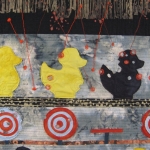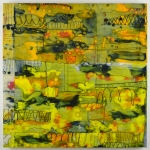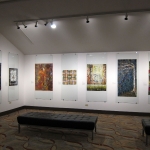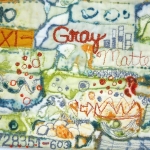We had such fabulous warm weather this past weekend, I just couldn’t help myself. I got out my pots and buckets, soy milk and alum, silk and cotton, and browsed the yard with my clippers.
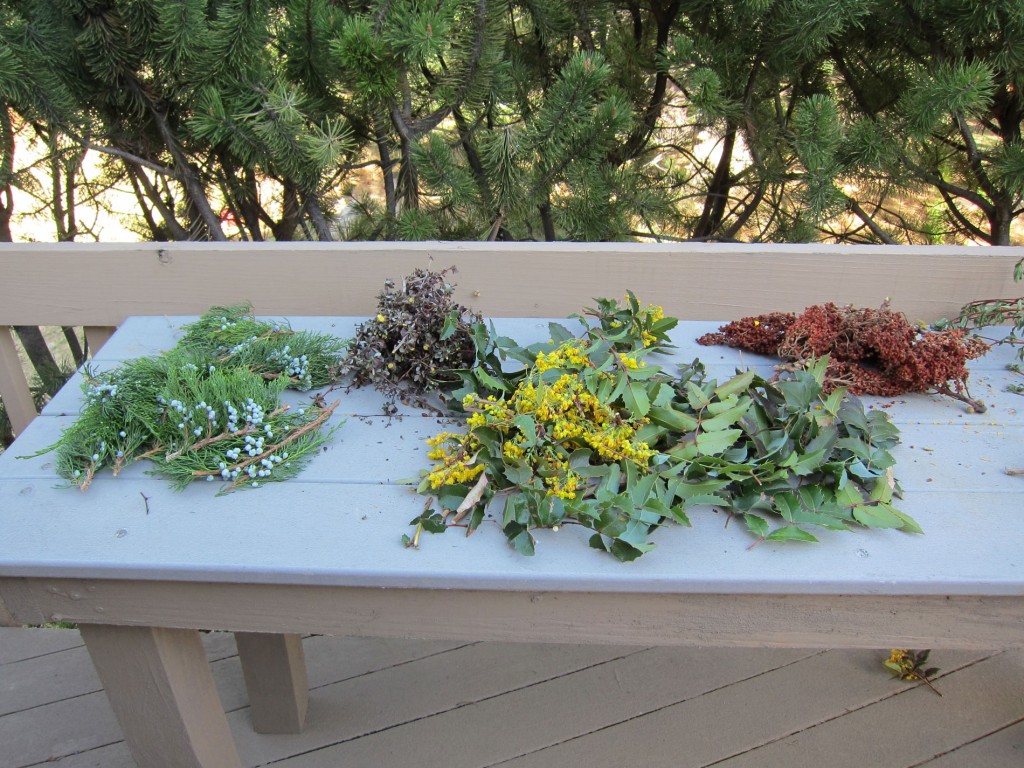 Plants for the dye pots, (from L to R) Juniper, some purple-ish bush from the front yard, holly, sumac berry pods. In an effort to get the best wash-fast and bright colors, I pre-mordanted the fabrics in 2 different solutions, (1) silk and some cotton in alum and (2) cotton and linen in soy milk.
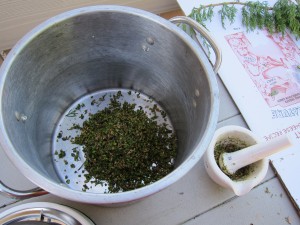 juniper berries 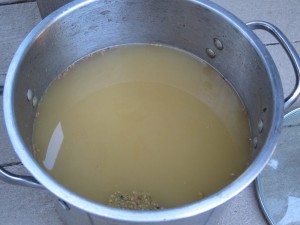 Juniper berry dye (after adding water and boiling)
I dyed 2 color groups – 1 in black bean juice dye (soaked the beans for 2 days, then soaked the fabrics in the bean liquid for 2 days with no heat), and the other was dyed with the juniper berry and leaf dye:
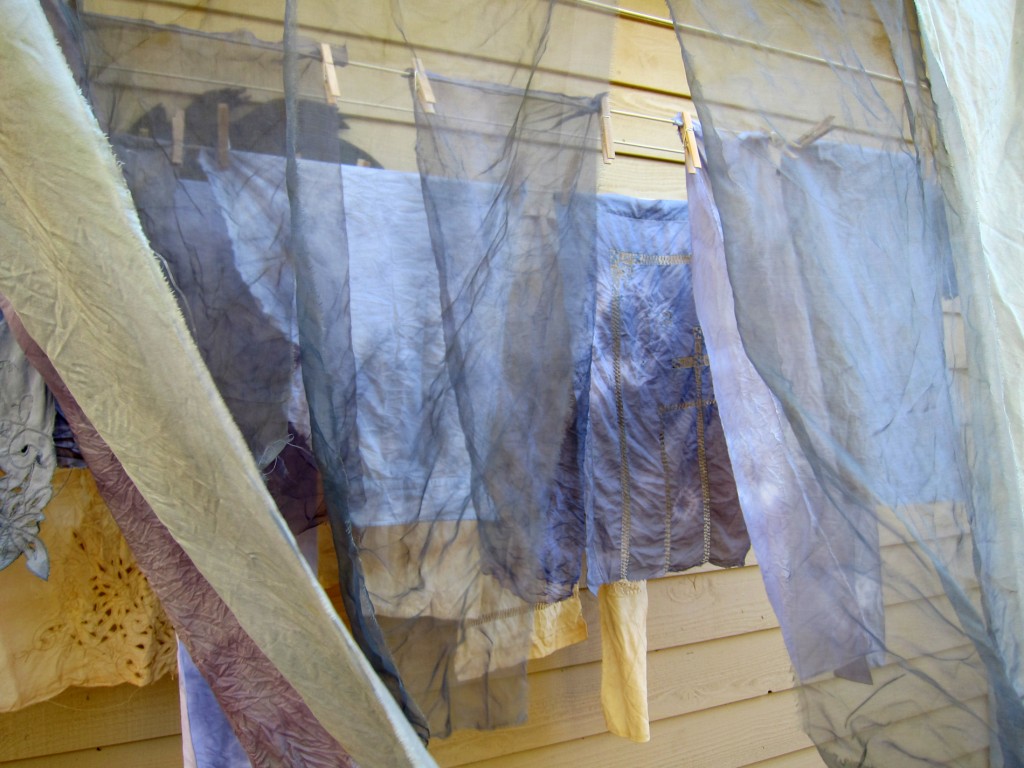 black bean and juniper dyed fabrics drying on the line Separately, I bundled up pieces of the various plant materials, wrapped with rubber bands and strings, and steamed them in a covered pot:
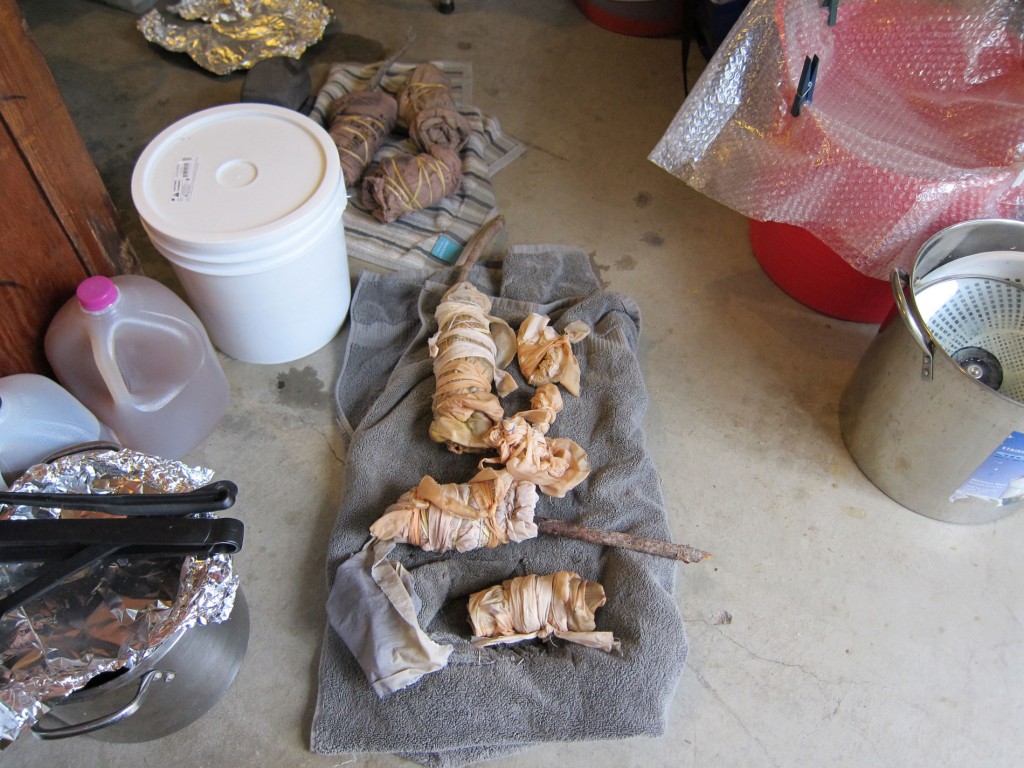 plant-filled fabric bundles, post initial steaming The bundles were quite attractive and mistaken for toys by my mischievous little brown-butted Emma girl!
 Emma is much more interested in my fabric bundles than her red ball and nylabone, seems she's developed a fabric fetish much like her mom The bundles are going to be left for awhile…patience in opening them is supposed to bring better results. I also still have several pots “brewing” with more fabrics and am going to see what colors I might be able to get from dyeing with a hot extract of the red sumac berries. I’ll post more pictures when I have some more interesting results to share.
For now, I’m enjoying the range of subtle blue/purple, yellow ocher in this group of alum and soy milk mordanted cotton, linen, and silks.
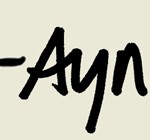
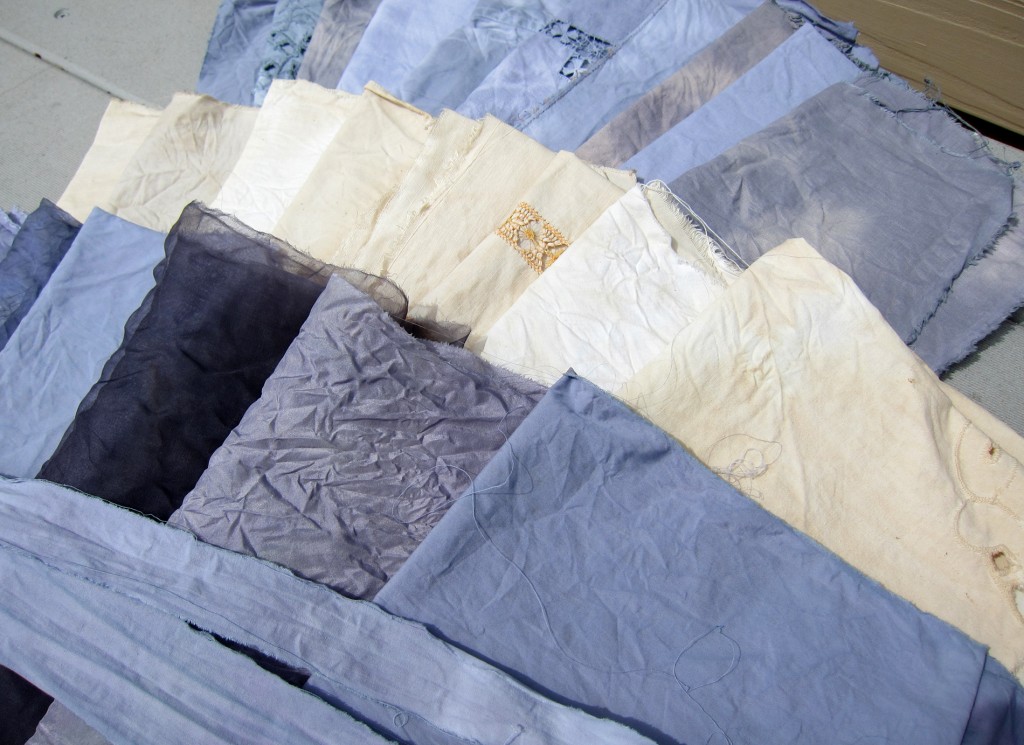 black bean and juniper dyed fabrics
Work in Progress this week:
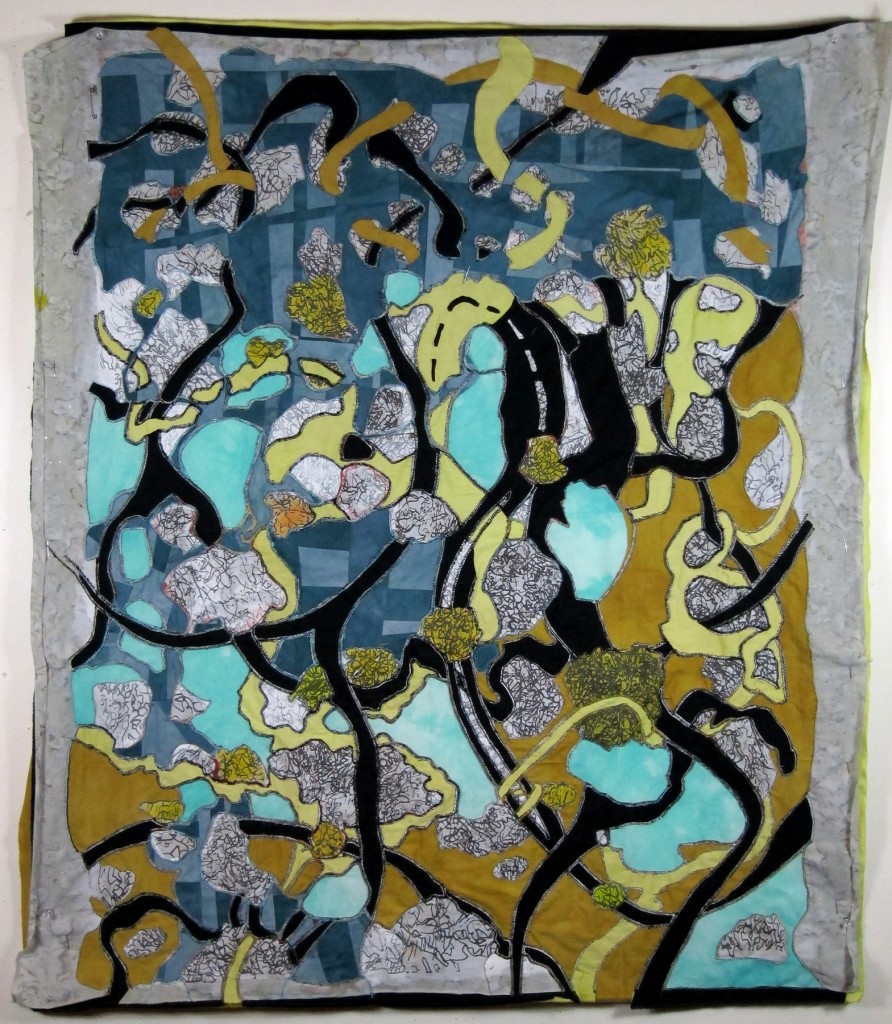 Work in progress state 4 ©Ayn Hanna It’s evolving. Here’s the previous photo I posted of this piece a couple weeks ago:
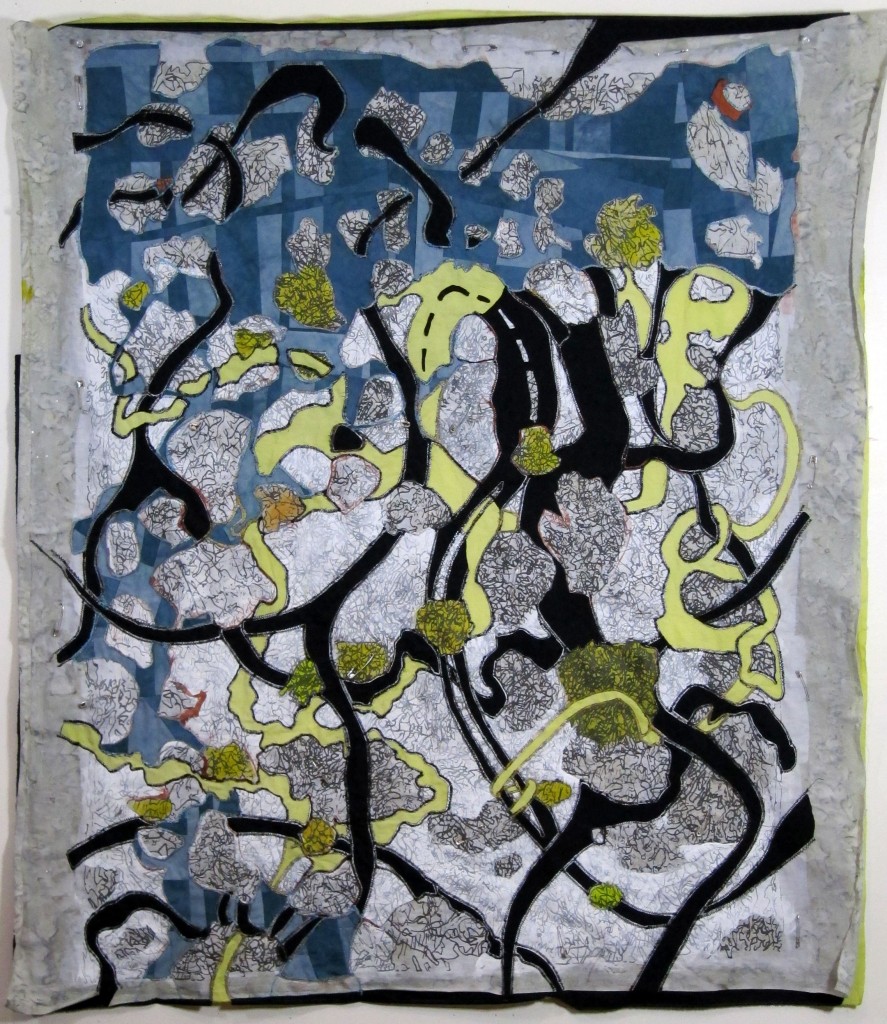 Work in progress state 3 ©Ayn Hanna And I’m continuing on my first attempts at cloth weaving. Here’s the first of the woven blocks that I have finished hand-basting and doing some hand-stitching on:
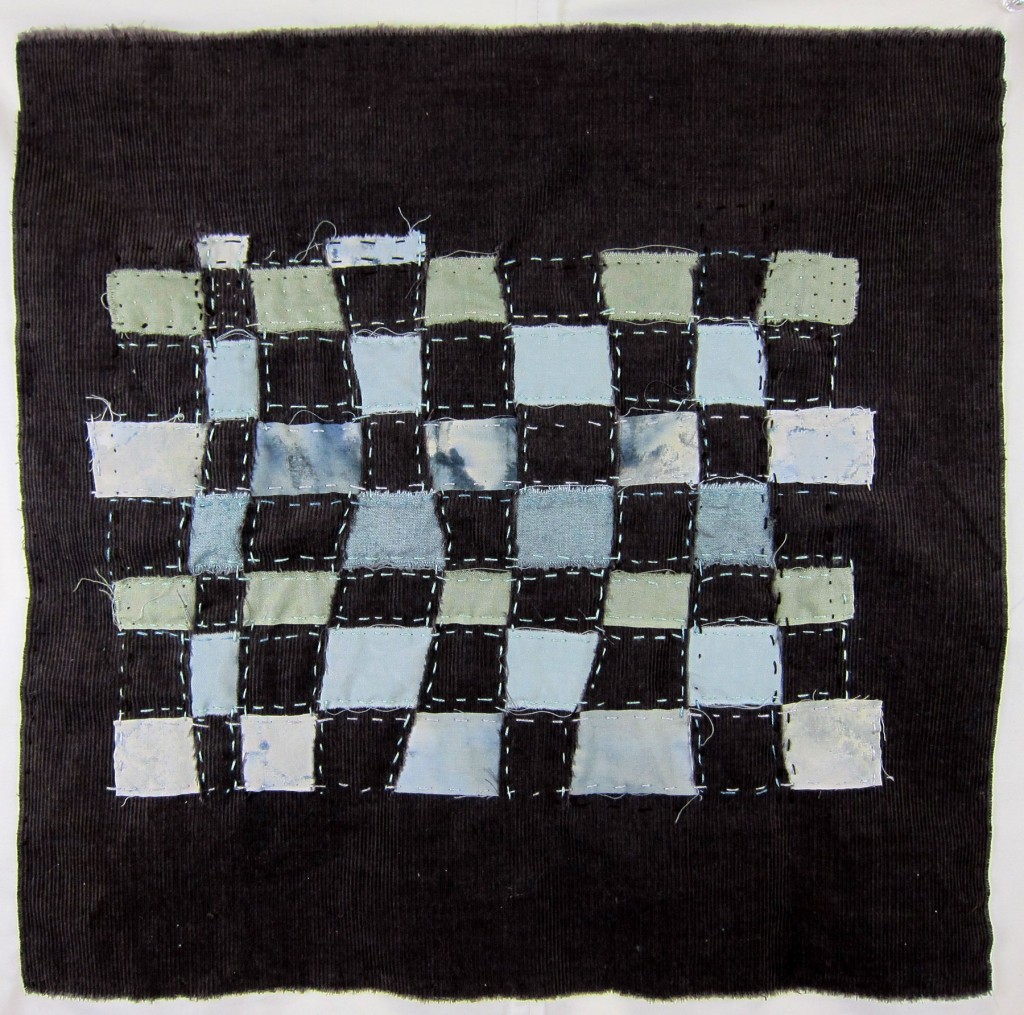 woven and hand-stitched block Working in this new way, weaving and hand-stitching has helped me slow down and take the time to consider some things.
#1 – As I’ve gotten “stuck” on what to do next toward resolving this latest work in process above, taking a break from it, sitting and doing some hand-stitching and weaving, gave me the necessary space to come back to it later with fresh eyes. With benefit of that break (along with some feedback from my partner) I now see more clearly what the piece needs next.
#2 – I’ve always been so driven to keep producing work, with career goals always in the back of my mind. That’s all still there, but something I’ve been thinking about (while hand-stitching) is: How much does an artwork suffer in our drive to “get it done” and get on to the next thing, pressured by the need to develop that body of work, get things ready for shows, etc?
Sometimes a work needs to simmer a bit, be set aside and worked on more slowly over time, as the next steps reveal themselves. One of my earlier pieces, Wall Drawing #1, took me almost 5 years to complete. During that time, it rested on my design wall which I walked past and looked at every day, yet entire months/year past without me actually working on the piece. Through periodic flashes of inspiration, I took the piece down and worked on it, then let it rest again until the next steps became clear. This piece came together quite slowly and naturally, with no deadline pressures.
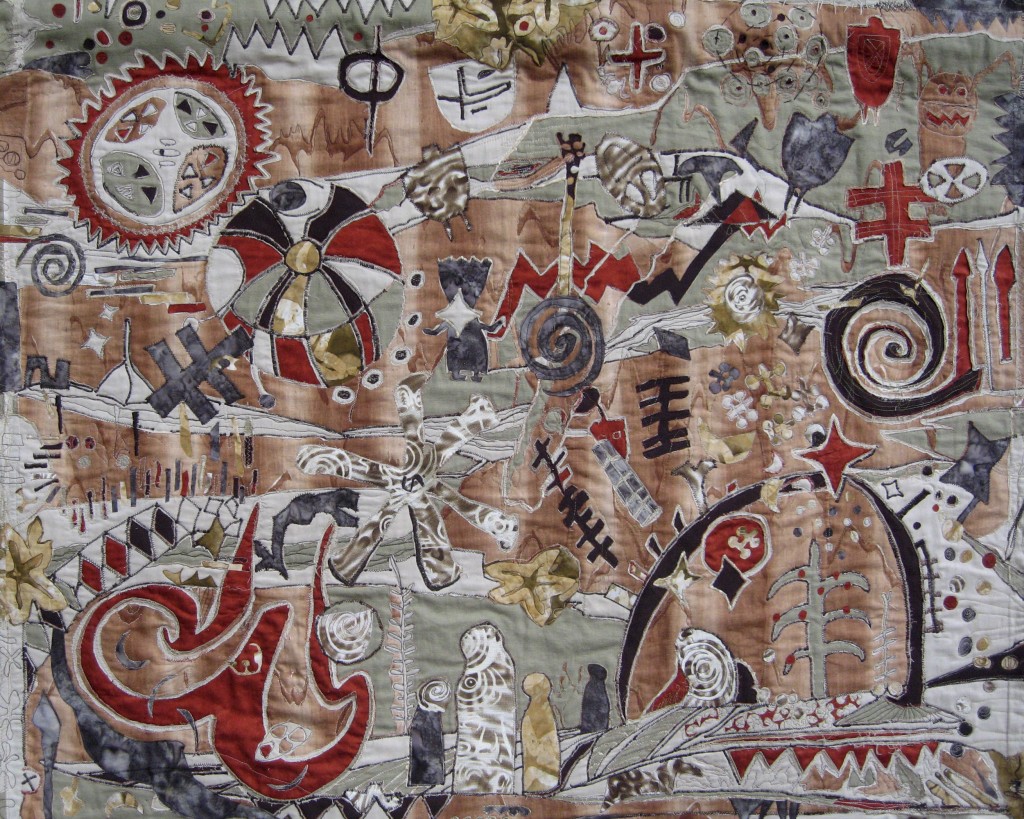 Wall Drawing #1 ©2010 Ayn Hanna 36"x45" Much as it might be nice to work with no deadlines, its just not practical when approaching making art as a business. Whether driven by deadline or not, each piece I make is packed with a lot of me, my spirit. The challenge is to balance getting things done with doing really great work.
Have any thoughts to add on this topic or other challenges you’re facing with your artwork? Please share in the comments below.

For those that haven’t been to visit my studio, or that have only been here during planned Studio Tour visits (when my studio is all cleaned up for visitors!), I thought I’d give you a glimpse of what the studio really looks like most of the time, when I’m in the middle of my creative flow.
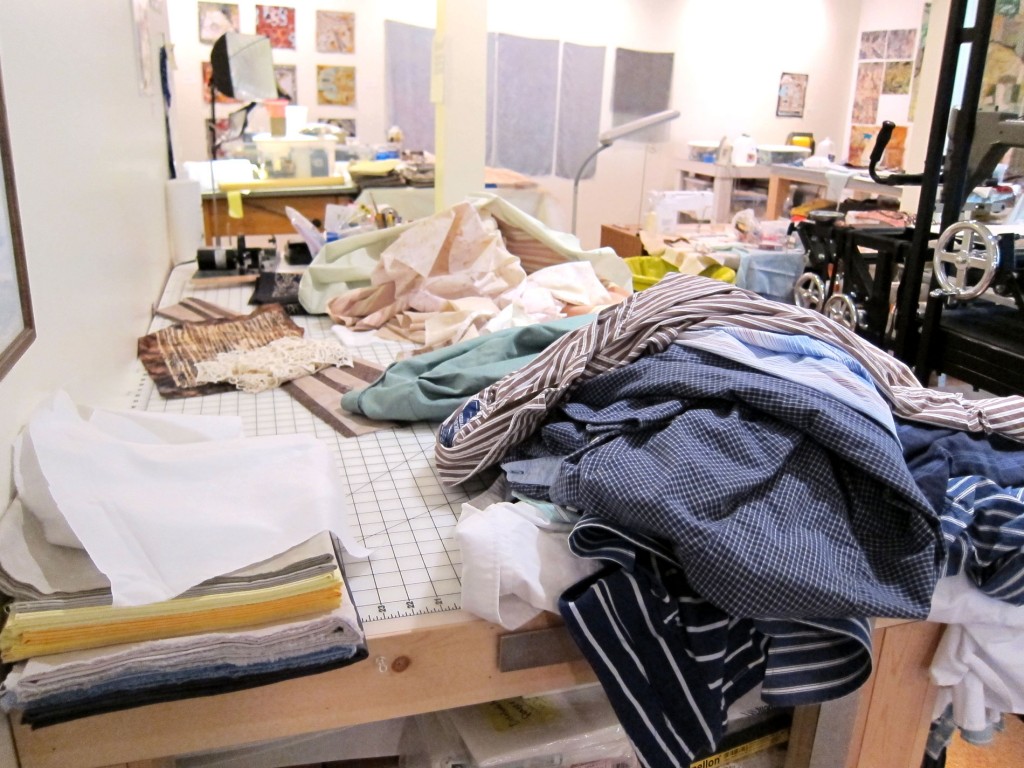 My fabric cutting table 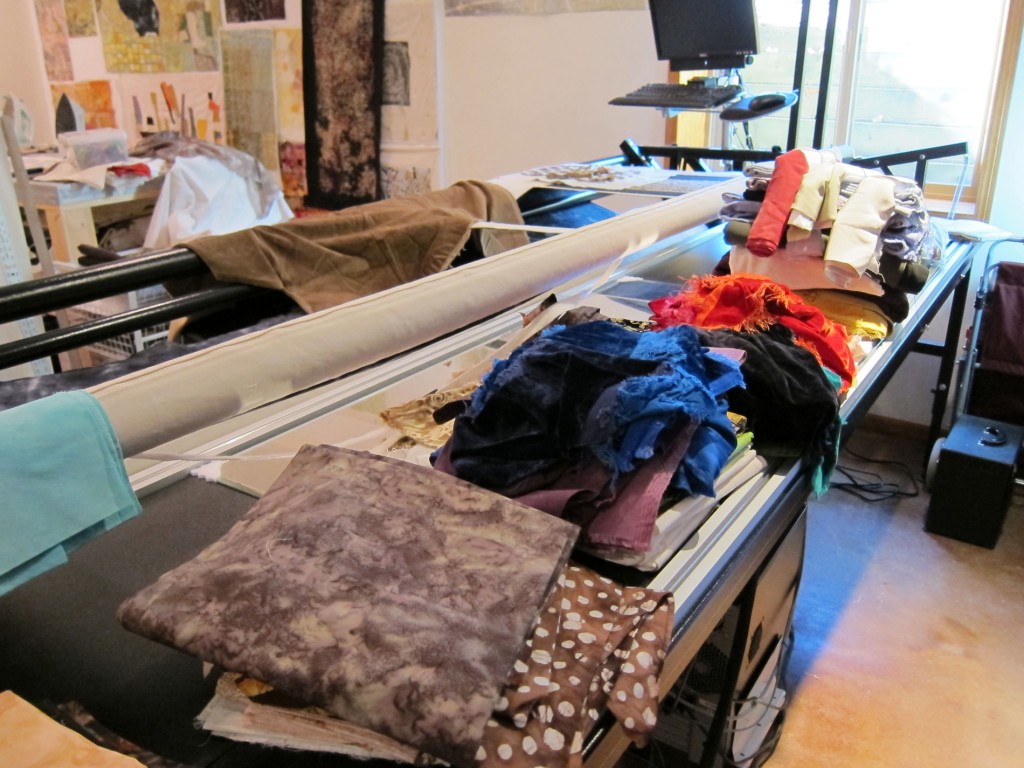 Auditioning fabric stacks along the backside of the long arm table I think it’s safe to say most every flat surface in the studio is covered with something:
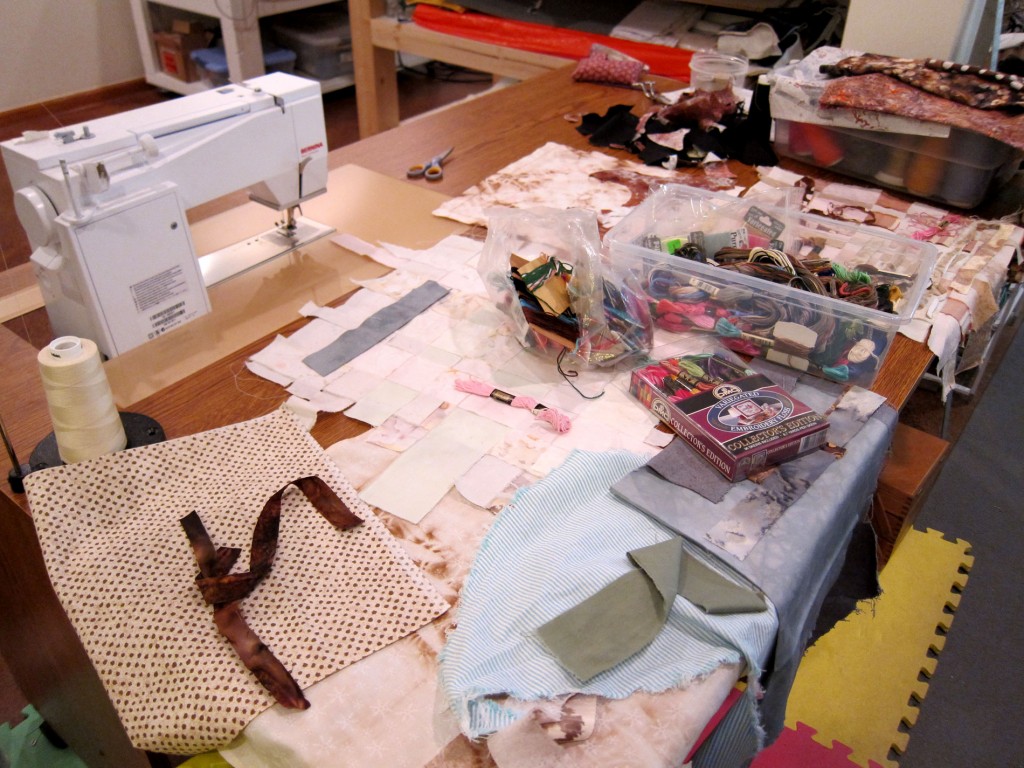 My Sewing table with some of my first cloth weavings, using my hand and eco-dyed fabrics. Here’s my ironing table, the silver gray fabric on the wall in the background is the silk from the black bean dye pot. The bluish fabric in the foreground is the cotton fabric from the black bean dye:
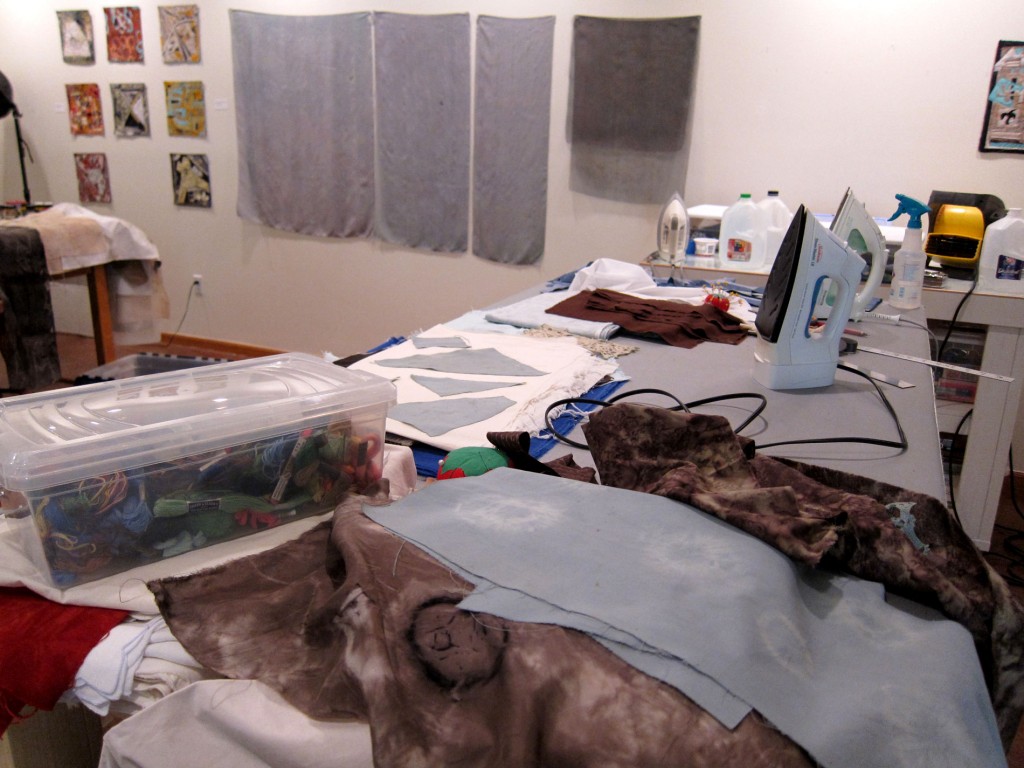 My Ironing table The long arm is more of a table right now….
 Another of my first cloth weavings, resting on the long arm Here’s a view of what’s on the sewing table from a different angle:
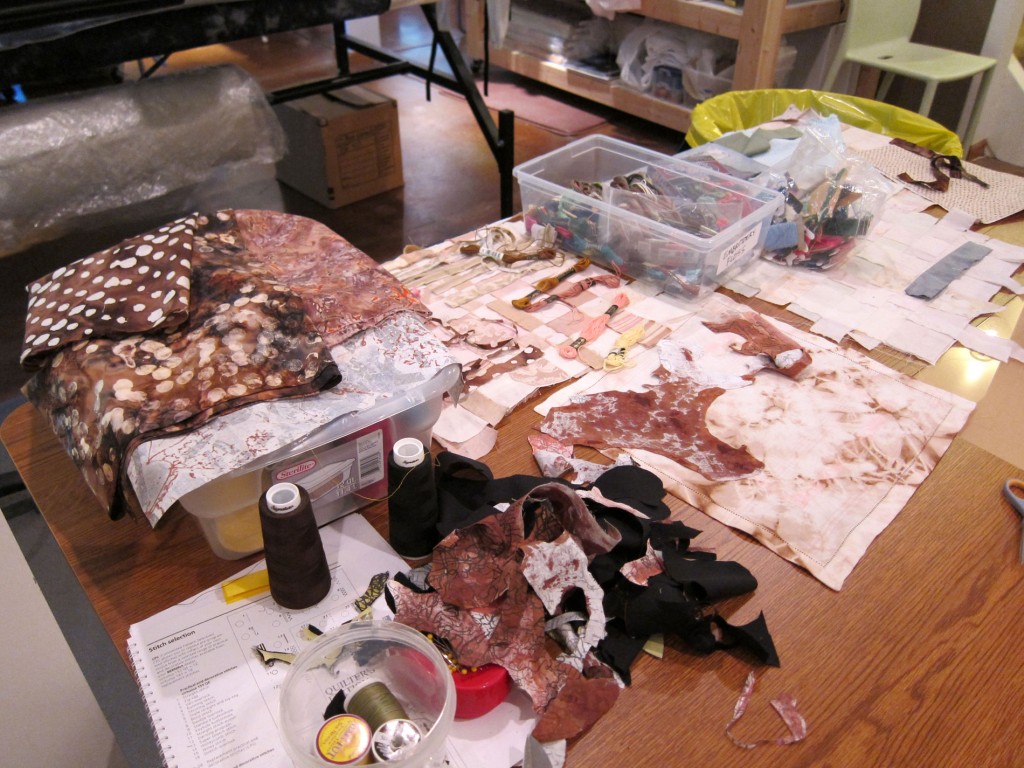 Sewing table, work in progress And the larger piece that I’ve been working on hangs on the wall on one end of the “gallery” area. The cloth on the table in foreground is some of my eco-dyed fabric from 2 summer’s ago:
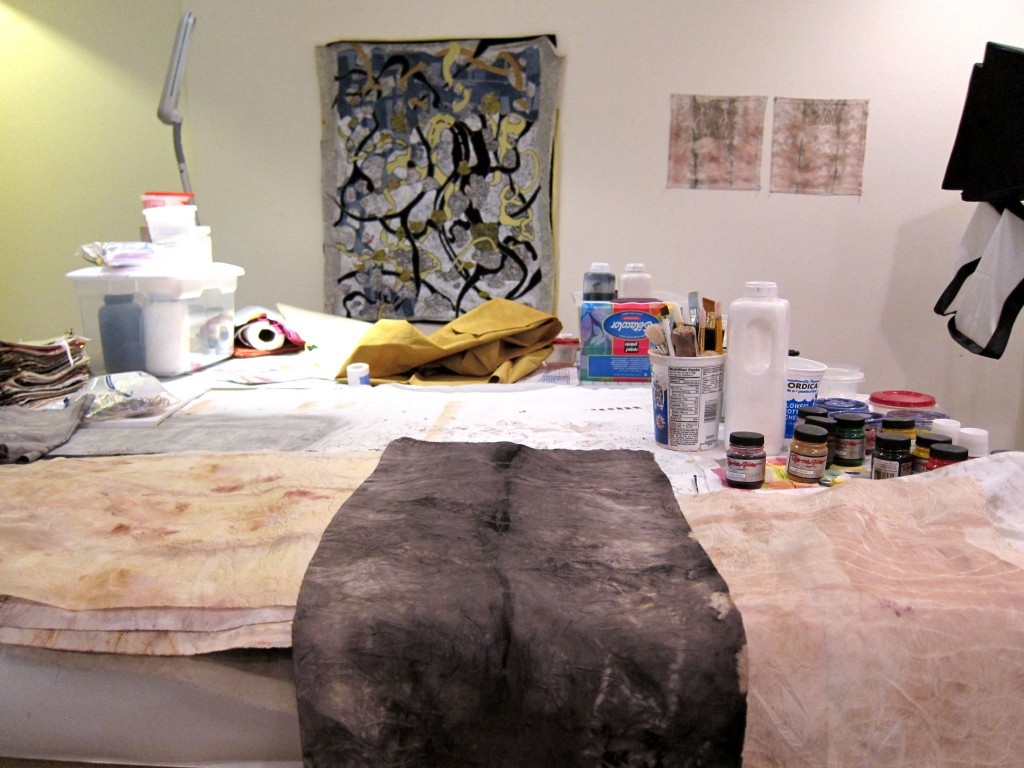 Eco-dyed fabrics in foreground, work in progress on the wall behind And lastly, a couple more of my first cloth weavings:
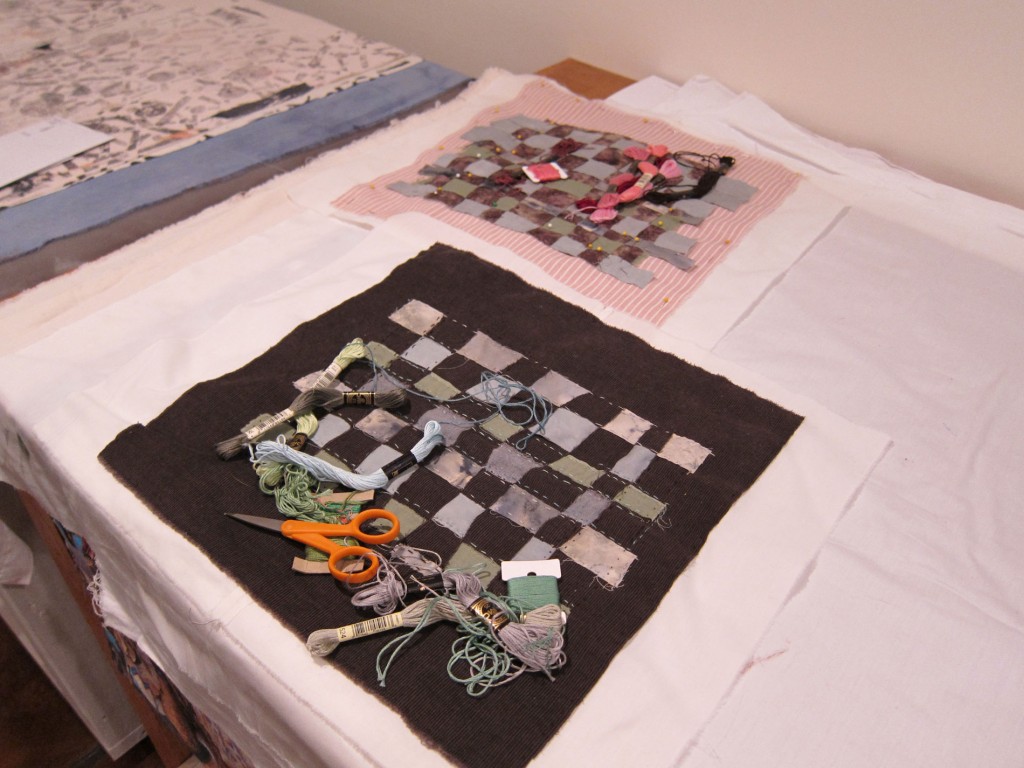 2 cloth weavings in progress So there it is. My studio in all it’s glory.
My Work in Progress
I have several pieces in progress, but most recently have been actively working on one larger piece (on the wall in background above), as well as exploring my first cloth weaving and hand stitching, as I’ve been drawn to Jude Hill’s Spirit Cloth blog and classes.
Through Jude’s influence, I have started using some of my “other” fabrics (beyond 100% cottons) for the first time and I’m liking the variety of textures this creates, as well as the different look and feel that can be obtained with combining these fabrics with the hand stitching. Another fun thing is I’m finding use for my eco-dyed fabrics, as they go nicely with this approach to cloth-making.
I’ve got 5 woven blocks started, and I’ve been mainly using a broad pink and brown color scheme, which got me wondering, where that came from? Why am I so drawn to pink and brown?
And then it hit me as I was falling asleep the other night – it’s my little red headed girl EMMA! She’s my brown (and pink-bellied) baby.
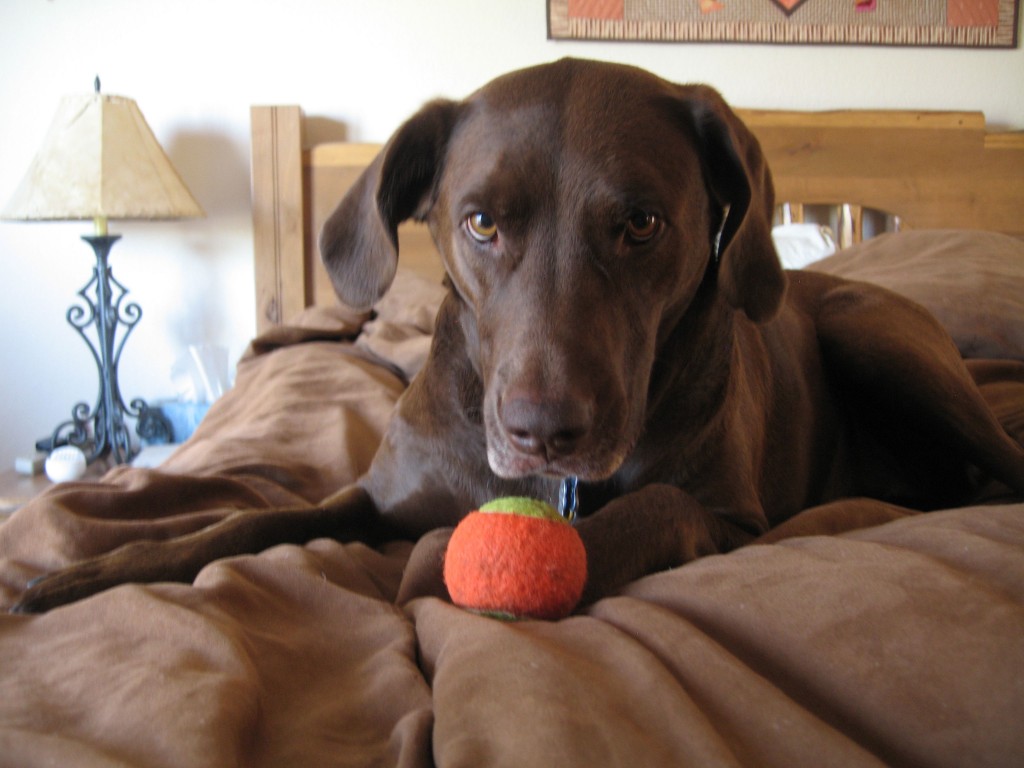 Are you happy with your current ball? My first Spirit Cloth work is a cloth about my Emma. And that makes perfect sense given the significance of animal spirits within Jude’s teachings.

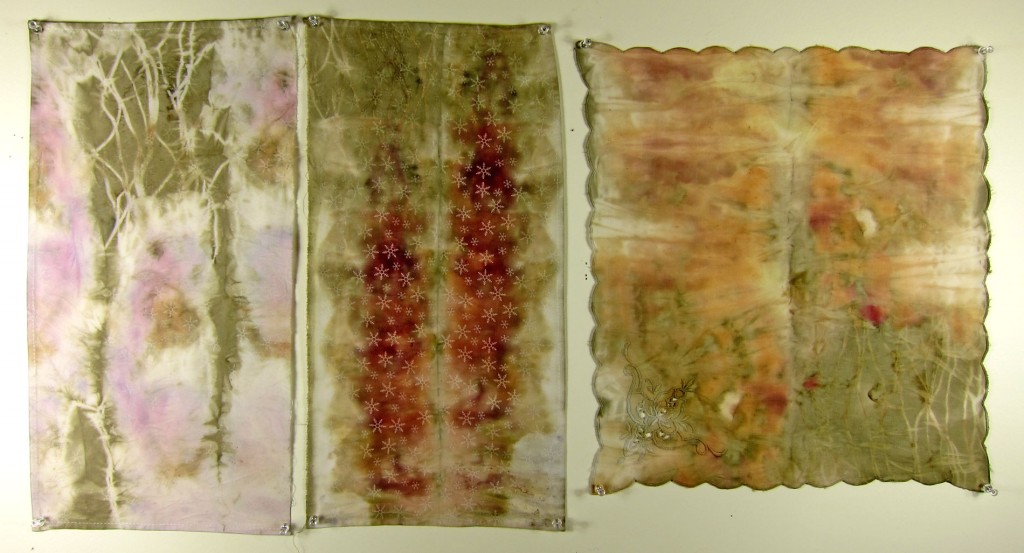 white cotton napkins, plant materials, soaked in water with metal pieces Eco dyeing with vegetables and tea on cotton and linen
It’s been in the mid-7o’s all week and with spring in the air, the eco-dye pots are calling. I’ve been playing with 2 different dye pots – one was nothing but a big pot of tea, in which I soaked some pieces of cotton wrapped around sticks from the back yard, the other was water with a couple of rusty metal bottle caps, in which i soaked pieces of cotton and linen napkins that had red/yellow onion skins and red cabbage leaves bundled inside and then wrapped around a stick. These fabrics soaked at room temperature for a couple of days.
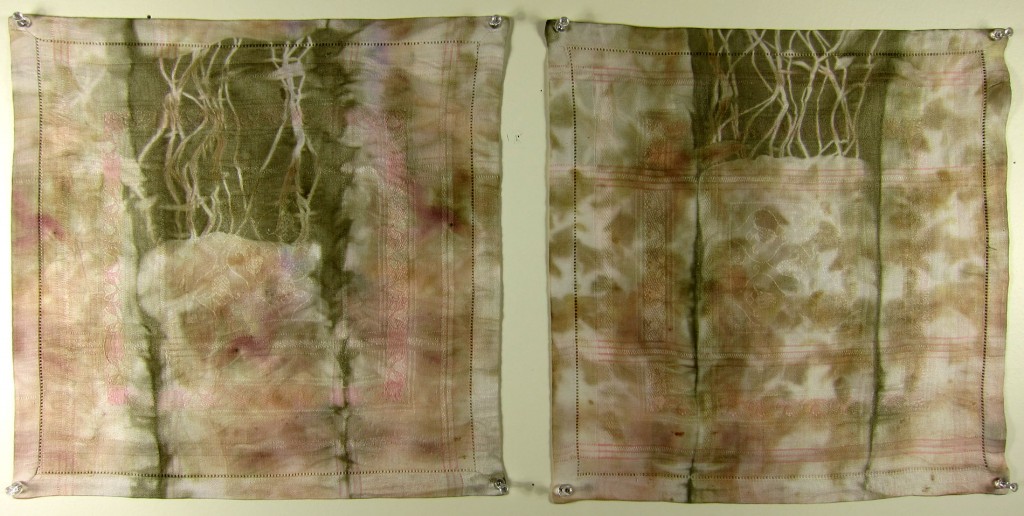 white linen napkins, red/yellow onion skins and red cabbage, dyed in a water bath I love the color surprises. There are so many variables to eco dyeing with natural plant materials, that unless you set up super-structured scientific parameters (measure and document and track everything) around fabric preparation, mordant selection, dye bath preparation, the results will include some mystery in the outcome.
This is exactly what attracts me to this – playing with different found materials, reading and researching what some of the “master” eco-dyers have to share, and trying out my own brews and concoctions. I do love process and experimentation, and using natural materials (no nasty chemicals) to achieve various color results is a fun challenge. Part of the challenge is not only achieving the color, but getting it to “fix” or remain on the fabric long term – plant dyes are very fugitive and susceptible to fading.
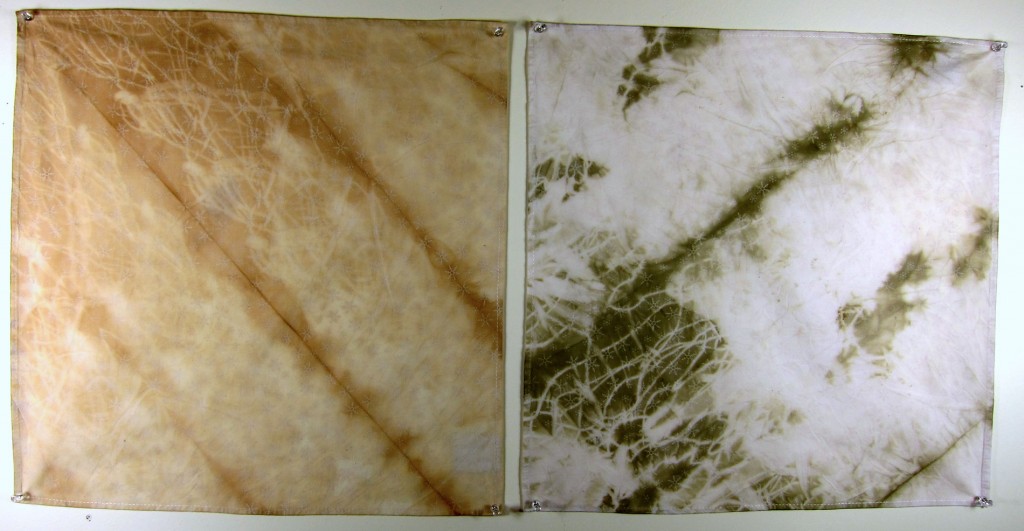 cotton napkins shibori-wrapped on sticks and dyed in tea bath (left) and water with metal (right) I feel another new workshop concept coming on…..not for this summer in Telluride, where I’ll be teaching a workshop on Breakdown dye printing at the Aha School for the Arts, but maybe next year (or even sooner if I can get something together locally).
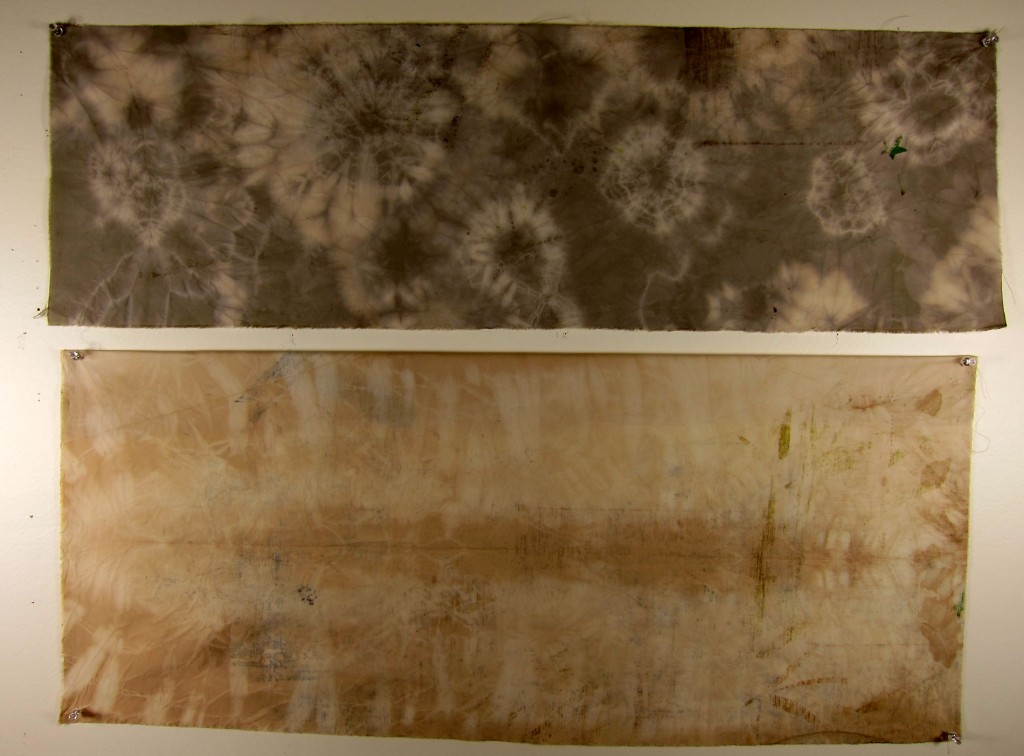 cotton fabric shibori-wrapped, bundled, dyed in tea bath (bottom piece), dyed in tea + water/metal dye bath (top piece) I’ve got another “brew” going today – a bag of black beans, soaked in water for 2 days. I’ve added some silk to the dark liquid and will let it steep for a couple days, then plan to add some cotton if the dye bath still has some life to it. Will share the results of the black bean dye pot once the fabric is done brewing.
Have you done any eco-dyeing and have any results to share? Please let us know in the comments below.

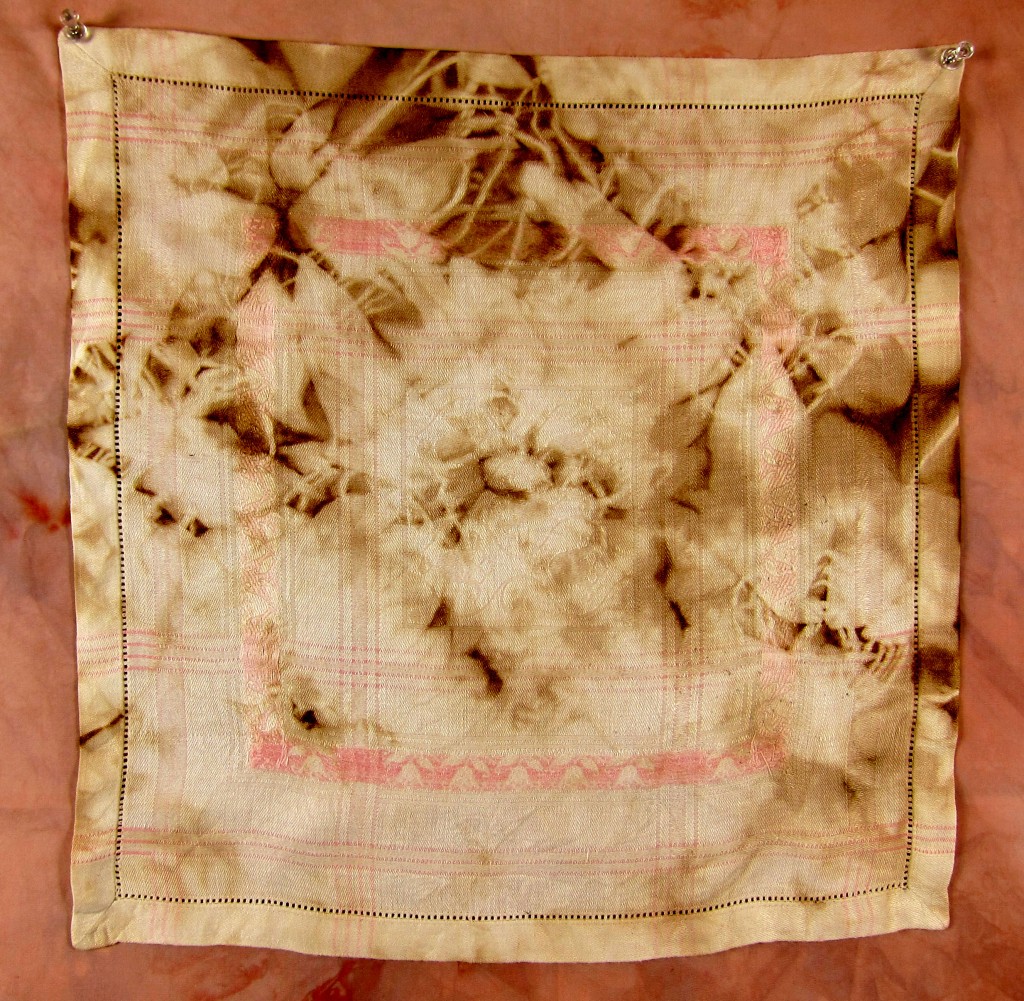 linen napkin eco-dyed with tea A Different Direction
Over the past week, I’ve reconnected with Jude Hill’s Spirit Cloth blog. It’s a soulful place where I take refuge when the daily noise gets too loud. The texture, layers, and spirit cloth draw me in. A place where slowness and contemplation is honored.
I’ve taken 2 of Jude’s online classes in the past couple of months (patchwork beasts and cloth2cloth) and signed up for 4 more. I’m inspired by the look and feel of worn/used cloth, natural dyed fabrics, and texture of hand stitching. I want to learn more.
In cloth2cloth, Jude teaches us how to weave cloth. Below are the first couple of woven blocks I’ve made, so far only basted with an invisible basting stitch, but ready for much more weaving, embellishment and quilting:
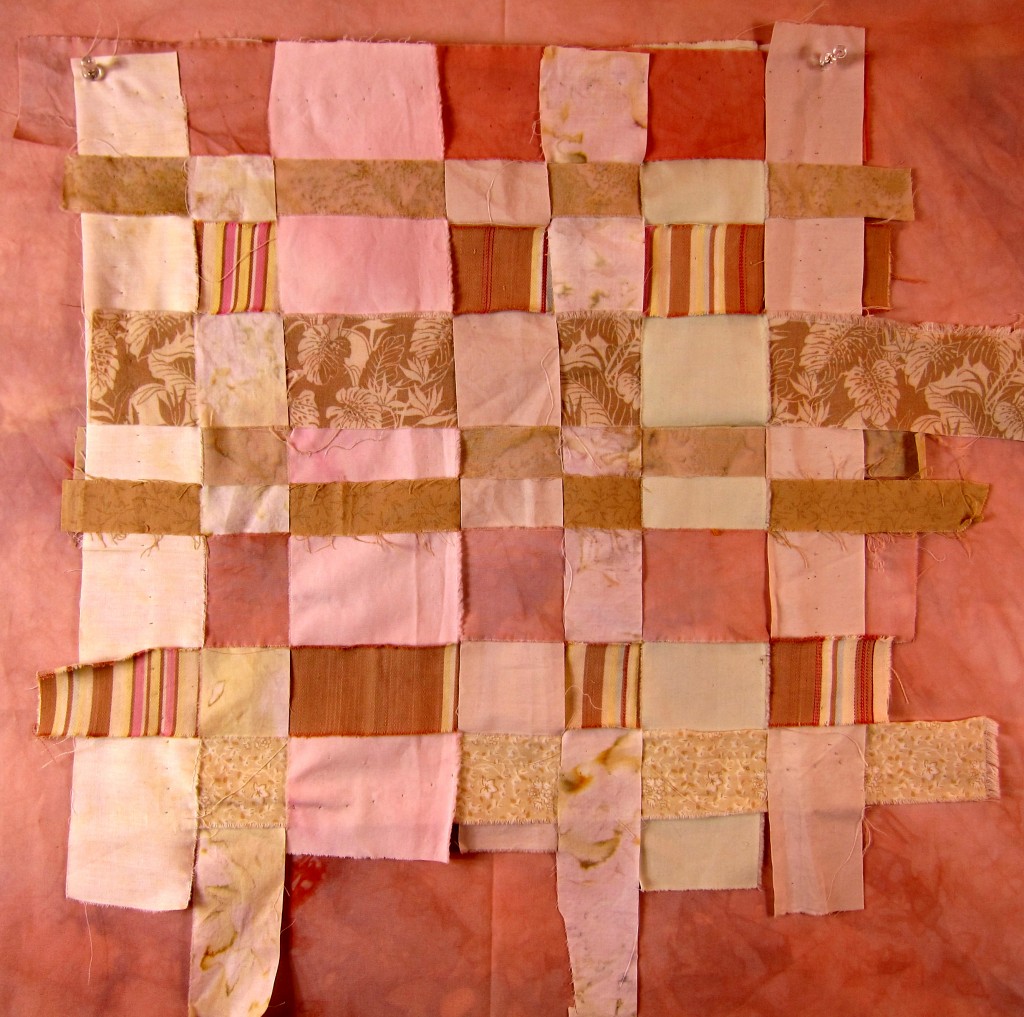 woven block 1 (my own hand-dyed fabrics and some prints, background is one of my hand-dyed fabrics) 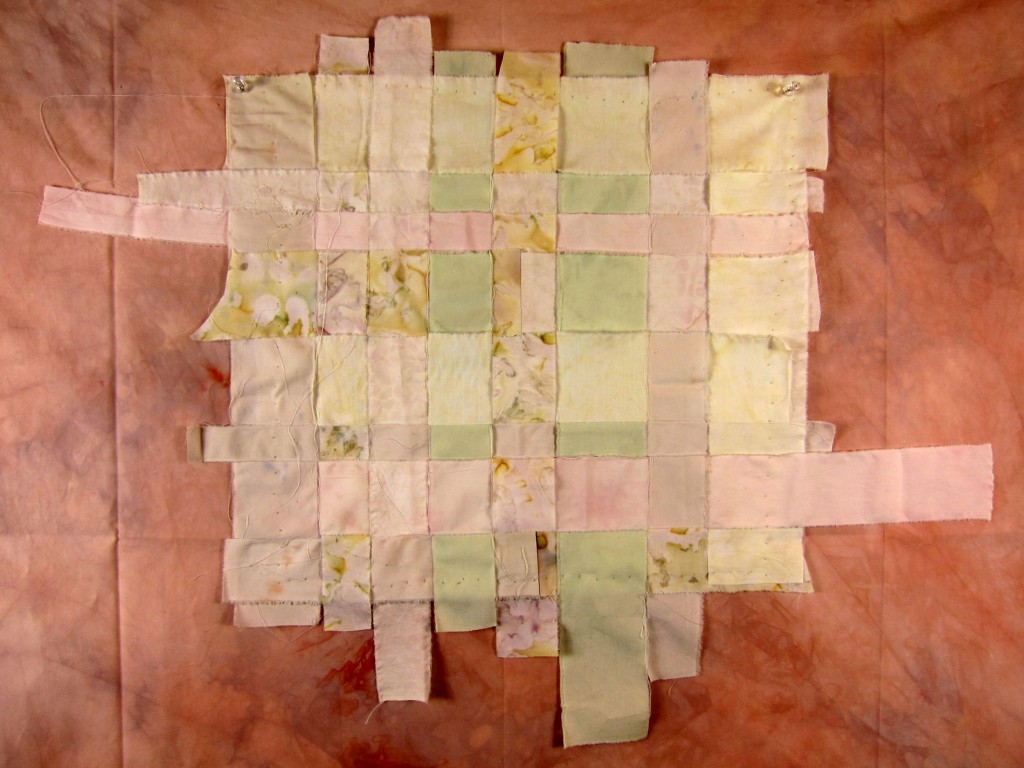 woven block 2 I’ve also been reading India Flint’s book, Eco Colour. I used principles that India teaches in this book to do my first eco-dyed cloth which I wrote about in this post. This past weekend, I dyed a couple of cotton/linen napkins using only tea. One is at the top of this post, the other here:
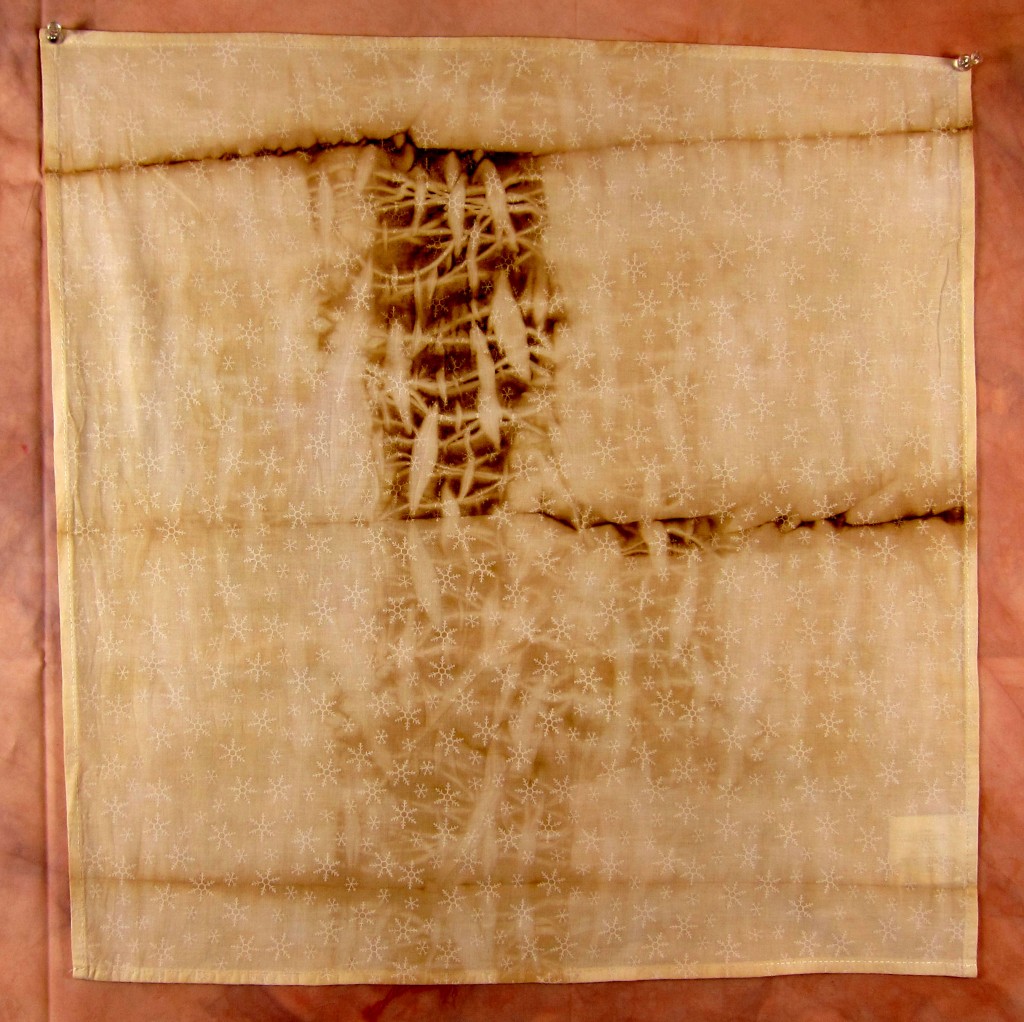 cotton napkin dyed with tea Unwrapping the bundled fabrics is magical, revealing the range of bold to subtle marks and patterns.
I don’t know where all this is headed. I just know its the right path for me right now – it makes my soul happy.

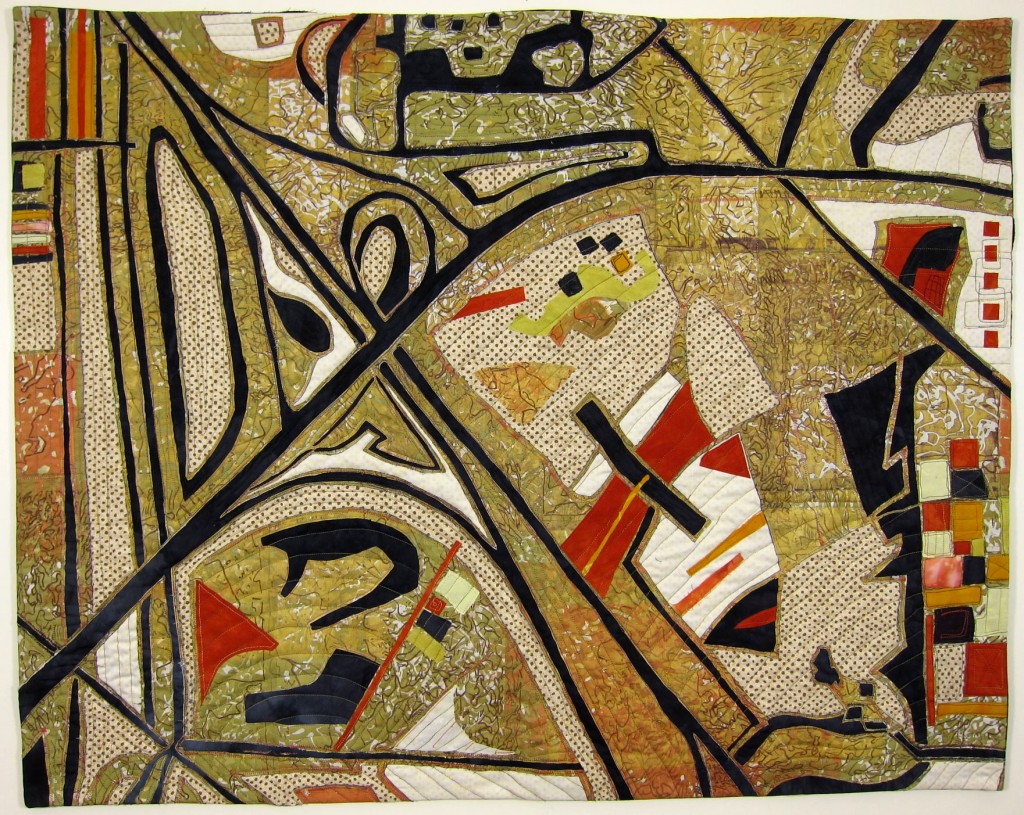 LineScape #12 (Fields and Highways) ©2011 Ayn Hanna, 31.5"x40", Textile Painting (cotton fabrics hand-dyed and silk screened by the artist, cotton stitching) M.A.P.S. * M.A.P.S * M.A.P.S
Remember those treasure maps from teen adventure stories, oftentimes one of the few visual pages in a paperback full of text? And board games too, the route laid out in winding colorful blocks, moving a piece along a path, picking up clues along the way? These are some of my earliest memories of my fascination with Maps, drawn not only to the cool visual elements, but also to the mystic sense of map as representation of some other place, whether real or imagined.
And who hasn’t been mesmerized by the images of mountains, earth, city, and sea below when looking out an airplane window? Makes the time fly by when sketching those airplane window views in flight.
One of my favorite things to do is review course maps after doing a big cycling event or a triathlon race and reconnect with my memories of different places along the route, reliving the energy and feeling of the moment. I’ve saved or downloaded the course maps from most of my events.
Maps are creativity in its purest form. Whether as a visual record of a place, event, memory, or idea, maps exist as a record of the maker’s artistic expression, bringing the unseen idea into visual representation, or recording the memory of an event or place. And Maps are just plain cool visual images – I love the shapes, colors, and symbols of maps.
My New Series: LineScapes
During 2010, when I was doing web research to find images of Navy planes while working on the design of the quilts I made for the Navy Quilting Challenge, I stumbled upon some b&w aerial images of abandoned Naval airfields and was struck with how beautiful the compositions were. These became the initial inspiration for starting my LineScape Series. In late 2011, I made 9 small textile paintings, each 12″x12″, based on these aerial maps. You can see the full group of them here. I imagine I’ll do more.
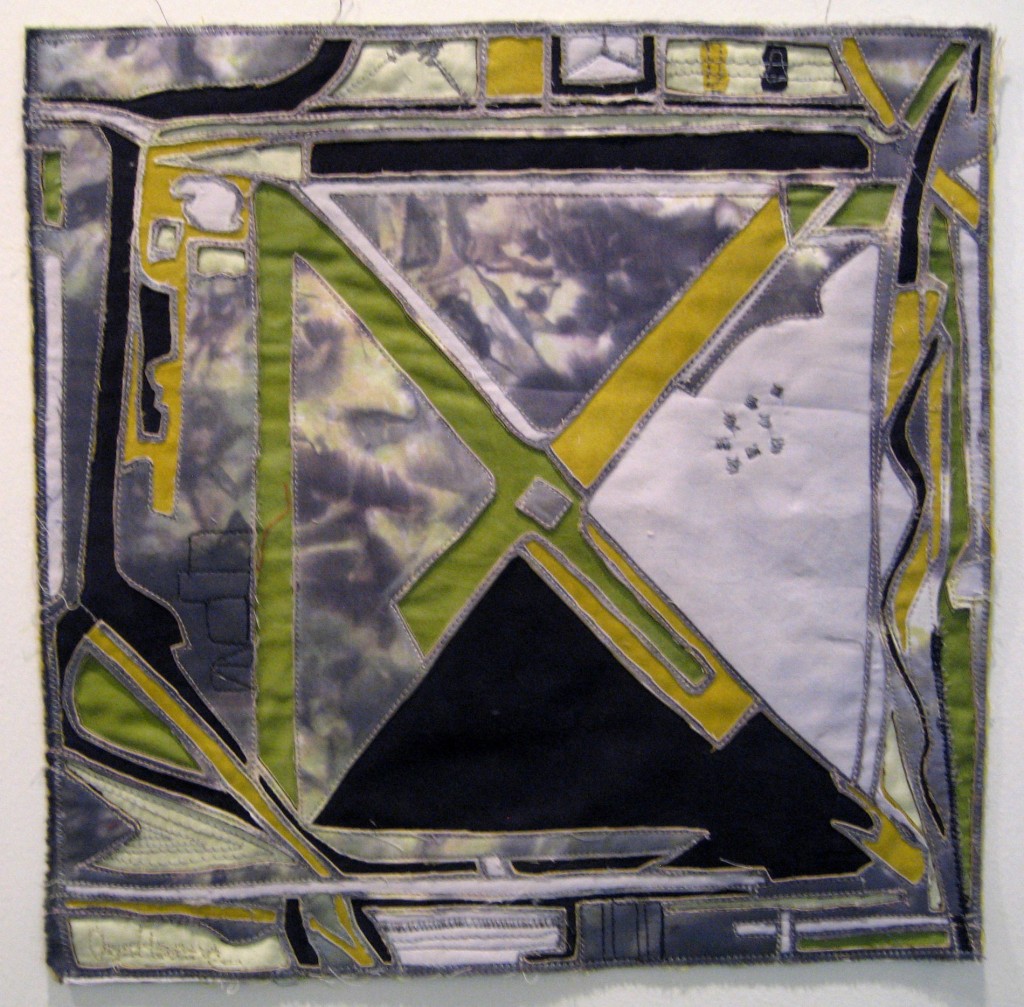 LineScape #7 ©2011 Ayn Hanna 12"x12" Textile painting (5 layers hand-dyed cotton fabric, cotton stitching) This series also includes images that are “map-like”, an extension of visual map forms and imagery with an exploration of the use of line (hence the term LineScape for the series), such as this one below:
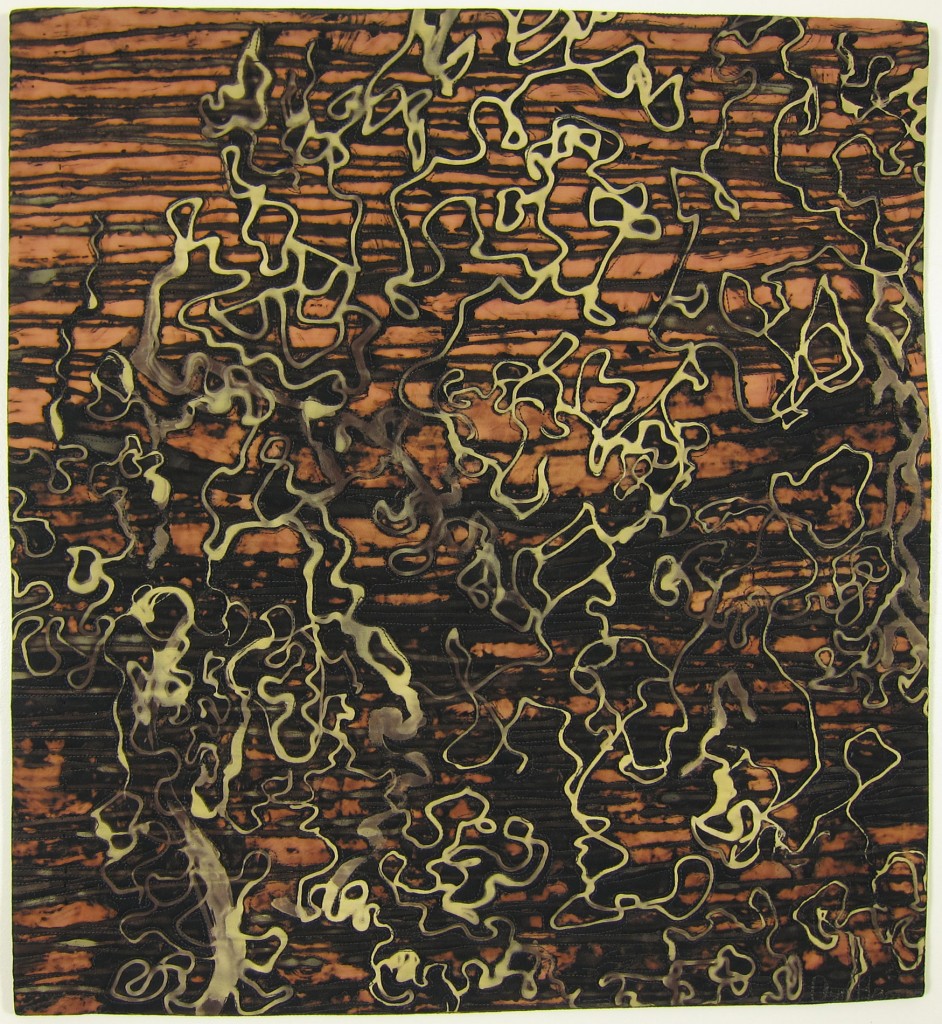 LineScape #13 (Squiggles) ©2011 Ayn Hanna 20.5"x18.5" Textile Painting (discharged whole cloth black cotton fabric, cotton batting, cotton stitching) And, per my comment above about reviewing course maps from events that I’ve done and reconnecting with “the moment”, this series will include some personal map imagery of events and places that are very special to me, such as the one below (in progress) of one of my favorite local triathlon courses:
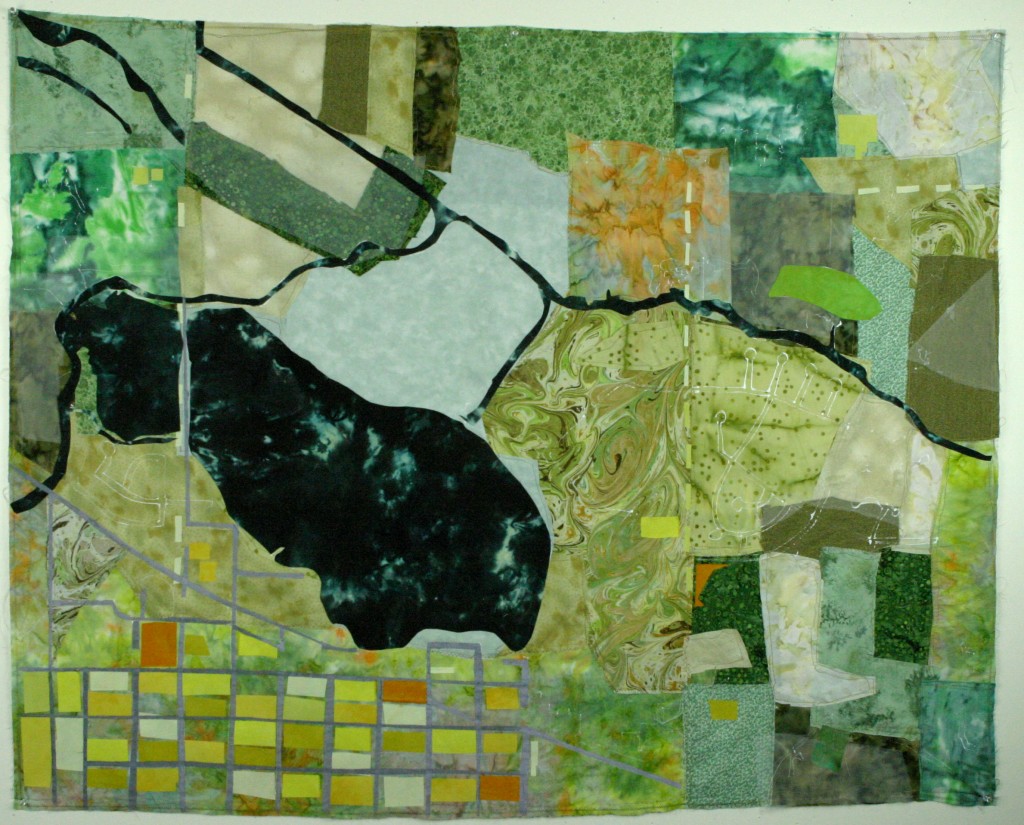 Pelican Lakes (in progress) © Ayn Hanna I’m excited about this new series and the many directions it may evolve. There’s something very soothing and natural about Maps. I’m very drawn to them as a form on many levels and curious to see where this path, exploring Maps and Lines and Scapes, will lead.
Anyone else have a strong attraction to maps? What is it that captures your interest? Please share in the comments below.

Anything is Possible
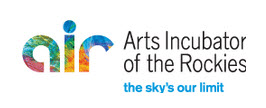 The Sky’s our Limit – That’s the motto of the new AIR Program (Arts Incubator of the Rockies) which is being developed by Beet Street, a local Fort Collins non-profit organization which exists as a catalyst to develop Fort Collins into a nationally recognized arts and culture center and destination by distinguishing ourselves as an intellectually vital community that fosters, celebrates, and inspires human creativity. The Sky’s our Limit – That’s the motto of the new AIR Program (Arts Incubator of the Rockies) which is being developed by Beet Street, a local Fort Collins non-profit organization which exists as a catalyst to develop Fort Collins into a nationally recognized arts and culture center and destination by distinguishing ourselves as an intellectually vital community that fosters, celebrates, and inspires human creativity.
I first heard about the AIR Program in Nov. when Beet Street Executive Director Beth Flowers gave a presentation about the vision and status of this program during one of the monthly Arts and Drafts nights that Beet Street sponsors at various arts locations around town.
I knew from that first introduction to the program concept that this is going to be a VERY cool program with the potential to create a paradigm shift for artists and communities in the Inter mountain west region (IMWR). I wanted to get involved in helping make this vision a reality.
WHY I wanted to get involved
1. I love the vision and mission of this program: The focus is to build a self-sustaining arts economy and arts culture in the small towns and communities of the 10 state region of the IMW (this includes CO, WY, NE, MT, ND, SD, ID, UT, NV, NM), by offering programs to both “Creatives” (artists of all persuasions) and the Community to help develop both supply and demand for ART in our region and embed ARTs in our culture.
While the focus is on serving the small communities and artists in remote locales of the IMWR, the reality is that once the curriculum offerings are set up and made available via various distance learning/internet-based methods, the target audience of this program could really become broad, even worldwide. From the AIR program website:
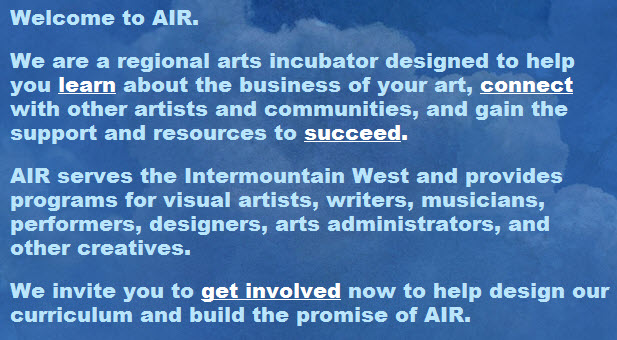
2. This is a first of its kind effort and its entirely do-able: There are other ARTs incubators out there, but this is the first one that goes beyond a single state or entity focus, intending to reach a target audience of +280,000 creatives across a 10 state region. Beet Street and the City of Fort Collins have developed such a great vision for this program that they won a large NEA grant this past year to help fund the program development.
3. Giving Back, Connecting, and Building Relationships: As I wrote in my last post, I want to contribute to my community, get involved in efforts where I can help build the economic Arts engine and value of Art in our culture, and I am focusing more this year on Connecting with my tribe. Getting involved in this program is a great way for me to use my graphic recording and facilitation skills, working with like-minded Creatives on a topic area I am passionate about.
Taking Action
I applied and was selected in early Jan 2012 to participate as a volunteer curriculum advisory committee member, to work with ~30 others over the next several months to define the “what, why, and how” of the AIR core curriculum offerings. Our “WHAT” committee has been meeting weekly since late January, defining the overall mission and brainstorming objectives and activities to achieve our intended goals.
We have a great group of people working together on 3 committees to define the program goals, objectives and target audience, to meet with businesses in the community and discuss how Creatives can help improve business outcomes (developing the “demand” side of the supply/demand equation), and to research the many delivery channels we might use to deliver our program to the target audiences.
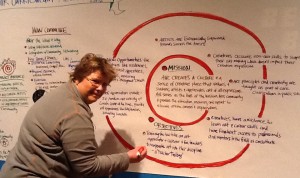 Recording the AIR mission and top objectives as output from the first Mega Committee Meeting. This past week we had a Mega Committee Meeting with all 3 of the committees together, along with the Beet Street Board members, to present our progress updates, and to align as a large group on our mission, our top objectives, and our target audience. I helped design and facilitate the Mega meeting and graphically recorded the meeting as well.
We achieved our meeting objectives – got updates from each committee, and came away aligned as a group on our mission, top objective areas, and target audience.
Next Steps
Next, we’ll continue to work through the details of identifying curriculum specifics that will achieve the objectives (WHAT committee), further explore developing the ARTs connections to Community and Business (WHY committee), and how we’ll deliver this program to the target audiences (HOW committee).
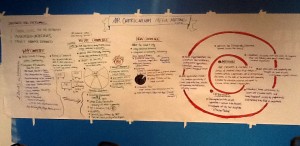 Graphic Recording of the Mega Committee Meeting output Our planned timeline is to wrap up the advisory committee work at end of April and have the initial curriculum being developed by the curriculum writers this summer and be able to do some pilot programs this fall, with a broad-based full program curriculum launch in 2013, including a first Regional AIR program Summit meeting in Fort Collins, with participants from all 10 states.
With every succeeding meeting, I get more and more excited about making this dream a reality. It is very real, we can make it happen – it is up to US to take the actions necessary to see it to fruition.
Interested in getting involved or learning more about the AIR program? Visit the AIR website for more details and progress updates. If you’re interested in ARTs in the Rockies, I think you’ll want to get connected in with this program in whatever way works best for you!

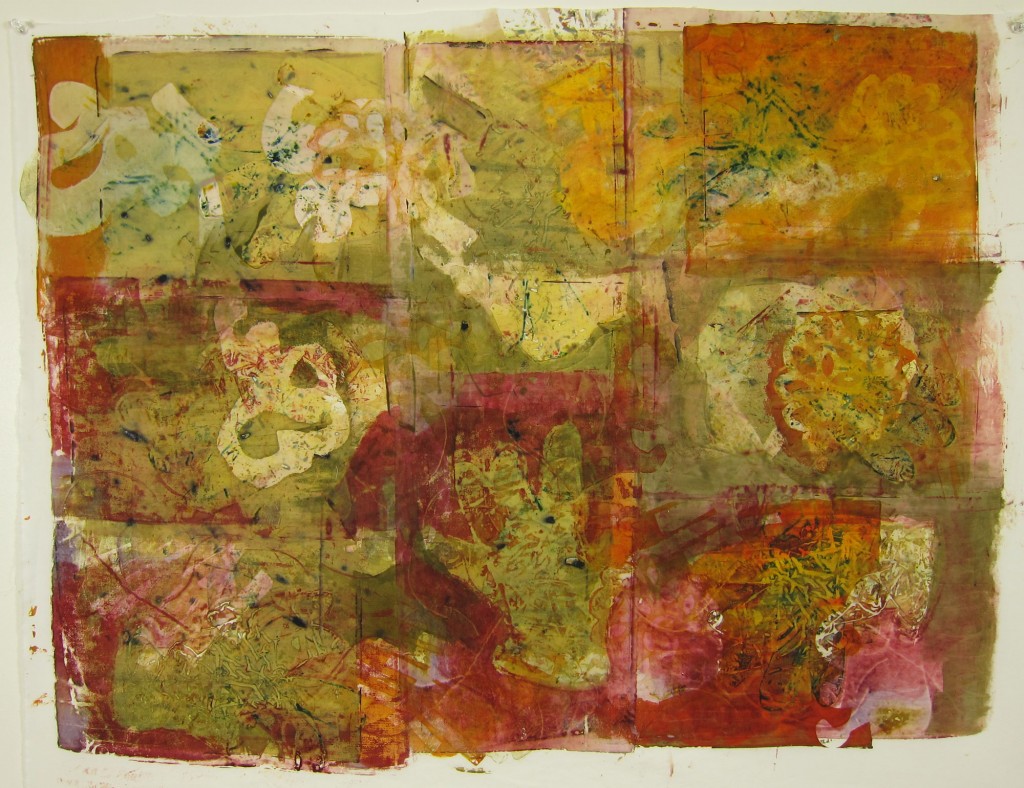 work in progress ©Ayn Hanna (MX reactive dye breakdown printing on cotton fabric) (I have ~14 works in progress in the studio right now and I’ll share some of them in upcoming posts. The one above was made using a breakdown dye printing process, demonstrated in this video by Committed to Cloth.)
Change is a Constant
“Snake” was the animal card I selected for 2011. It represents Transmutation, Change.
My 2 words for 2010-11 were FIERCE JOY. This Yoga Journal article best describes what I envision as “Fierce”, connecting with your inner Kali. And JOY, well, this simply is the state of being I most want to exist in.
2011 was a really great year and included many wonderful changes – lots of good forward progress with development of my art career, and major growth and change with my life partnership. I put a lot of energy and focus outward and feel good about my achievements.
This year, I’m adjusting my focus more inward, while also maintaining a balance with outward focus. It’s still about setting and achieving goals and being fierce, but in a softer, more contemplative way.
It’s about transmutation, meditation, taking “right” action, but with a deeper more compassionate, loving, and forgiving connection, to myself, to others, to the earth. It’s about finding ways to achieve (art) career goals, while developing my healthy relationship with myself and partner, as well as deepening connections in the community, Joy in all things, and appreciation for all experiences.
Connectedness, quiet reflection, breath, boundaries. Listening and responding to the evolutionary whispers of the inner voice. The transmutation that comes through deep connection to one’s core self.
My 2 words for 2012
I’ve been mulling several good options for my 1 word for 2012, and have narrowed it down to 2 finalists, one focused inward and one focused outward.
BREATHE – it’s the inner word that keeps coming to me and gives me a sense of calm and grounded-ness when my work day has overshot it’s boundaries and I’ve reached my threshold of max absorption. Coincidentally (or not), it’s also another Yoga word. A very highly recommended book on my must read list is “A Life Worth Breathing” by Max Strom, an acclaimed yoga teacher and speaker. Instinctively I know that breathing and meditation will lead me to where I want to be, further along the path toward fully being “me”, fully giving and receiving love, and finding joy in all experiences.
CONNECT – inward and outward, although I’m feeling a strong pull of deepening my connectedness not only to self, but to my tribe, my outward community. This is a challenge because its much more comfortable to cocoon myself in my studio (I love my alone time). But I recognize that part of being a successful artist is we each need to put ourselves and our art “out there”, becoming vulnerable to connect with others and develop relationships. I also want to contribute to my community, get involved in efforts where I can help build the economic Arts engine and value of Art in our culture.
So my 2 words for 2012 are BREATHE & CONNECT. They will be my focus, my theme for this year. And Fierce Joy is etched into the background as well.
How do you set your focus for the year? Have you selected “a word” for 2012? Please share in the comments below.

More pictures, less words.
Here’s the piece I’ve been working on. See how it’s changed in the past week?
 Work in progress ©Ayn Hanna Little by little it’s revealing itself to me.
One moment, I have no idea what’s next, but force (discipline) myself to stay with it and next thing I know, it’s clear as day the next few things that need to happen with it (subtraction, addition, what have you). Probably would help if I had more dedicated blocks of time to stay in that creative zone.
At any rate, I’m still working the process of being able to pop in and out of that creative space, during the brief moments I do get to make art.
Got any tips for how you get in/stay in the creative zone? Please share in the comments section below.

Here’s the piece I’ve got on my design wall right now.
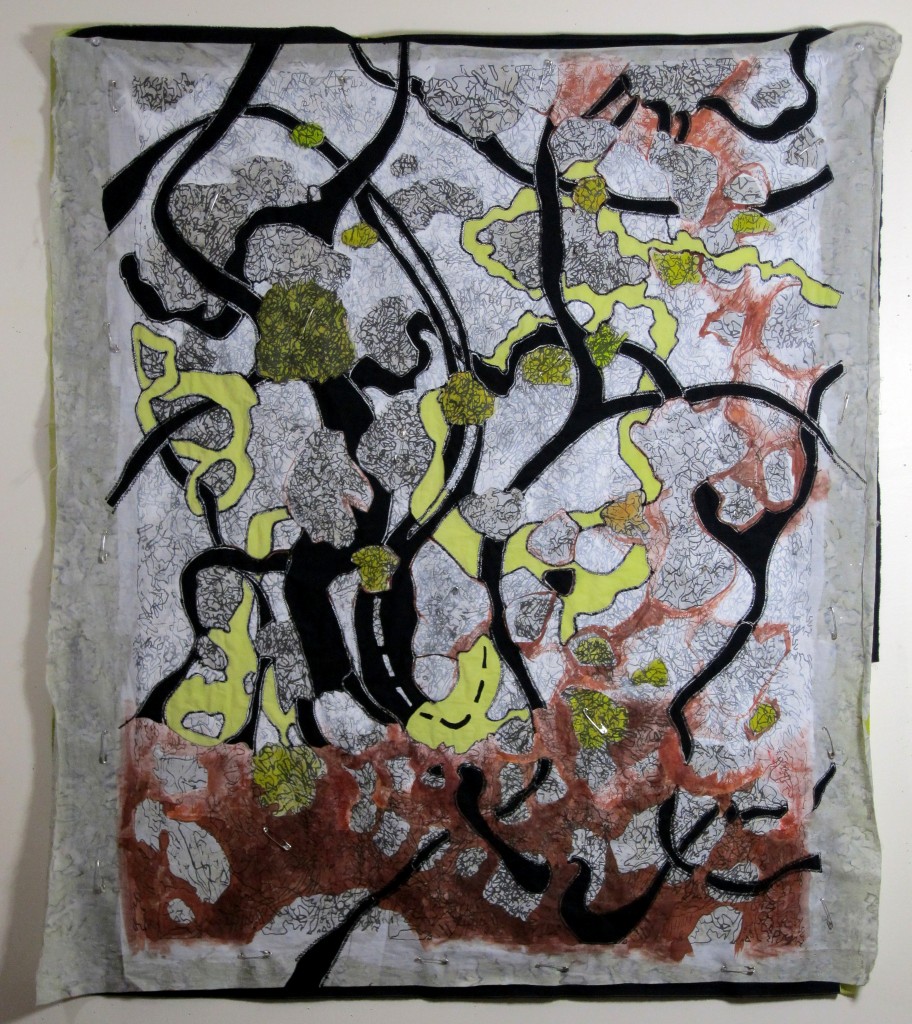 Untitled (in progress) ©Ayn Hanna It began as a piece of cloth that I had screenprinted a pattern on. I left this cloth on my studio wall for months, living with it and contemplating what it wanted to become. Eventually, an image began to form in the cloth and an idea for how to approach it.
I began by painting resist on some areas of the cloth and then discharging as much of the color out of the rest of the cloth as I could. This didn’t prove very effective, so I ended up painting over some of the active areas I wanted to lighten with white fabric paint, and also added some yellow ocher and burnt umber in other areas.
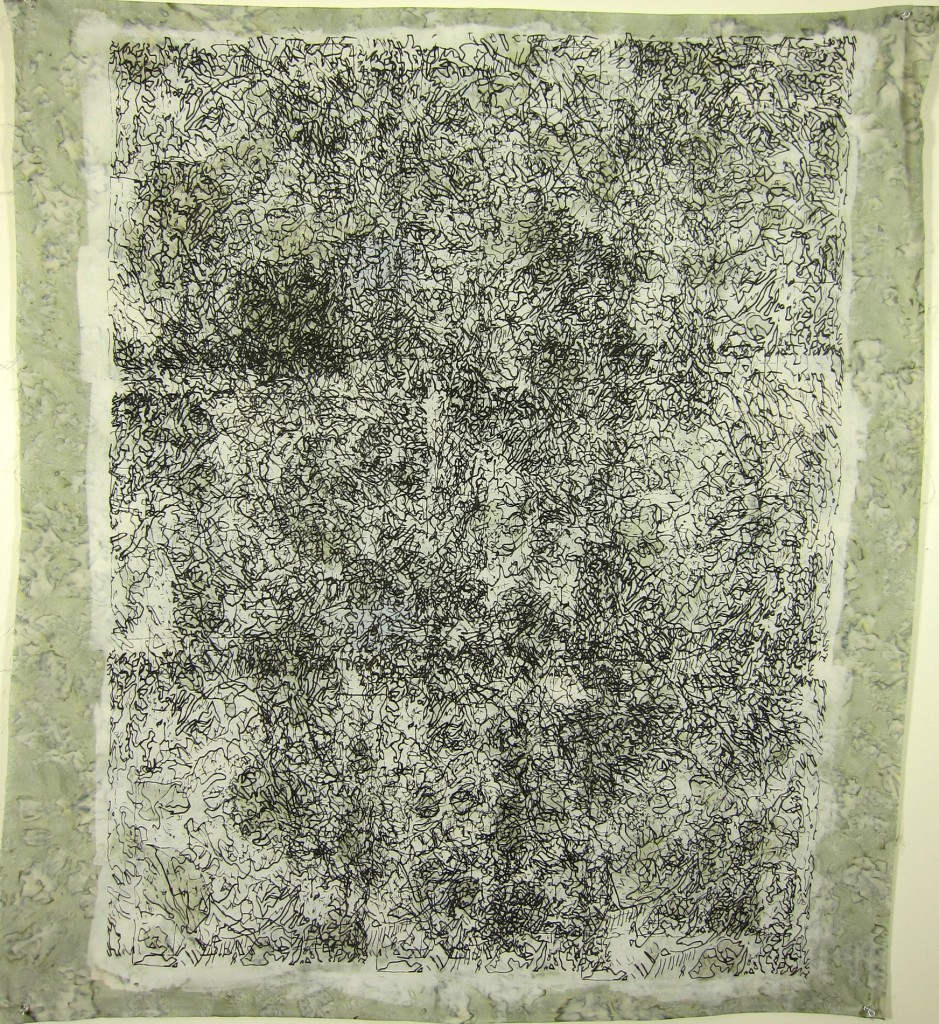 Beginning of this untitled piece - silkscreened artcloth, resist-painted and discharged. Next I added a couple more layers of cloth (light green, black) beneath the first layer and began to alternately stitch and cut away the layers to create the shapes, linear elements, and sense of positive/negative space.
This is very unresolved right now, both in color and form. Also of note, this piece has already evolved in a very different direction from the original image I saw. I will be adding more layers/colors as I work to resolve this piece. The next colors to join in are pictured below.
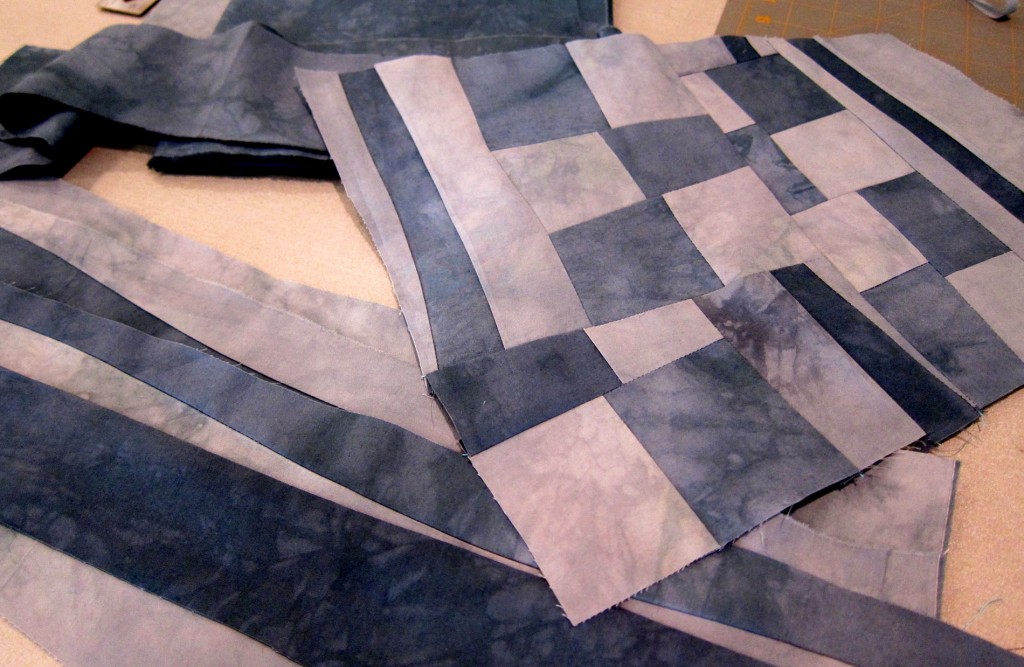 Fabrics that are next to be added to the piece. 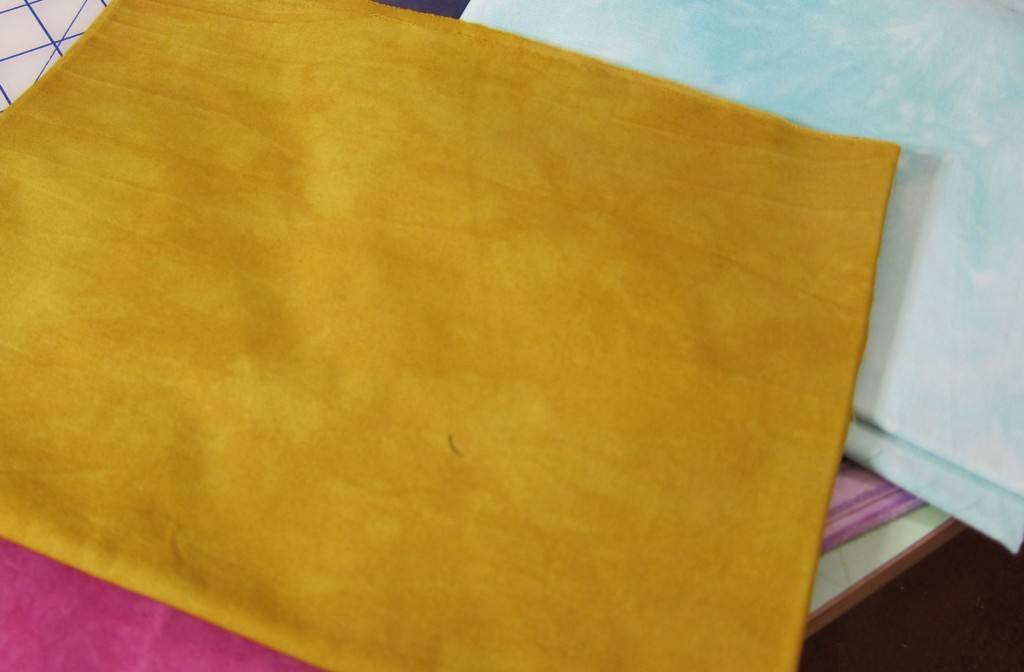 More color to be added. I do have several other works in progress in the studio right now (over 10) – that is typically how I work, with several pieces hanging on the design walls of the studio, I’m able to contemplate each of them. Depending on what processes are needed to resolve each piece, and which one I have the most energy about/clearest idea of what to do next with, I can move back and forth working between them, based on my mood and what type of creative process I want to use on a particular day.
What is your process for making art? I’d love to hear about it – Please share in the comments below.

|
|










































